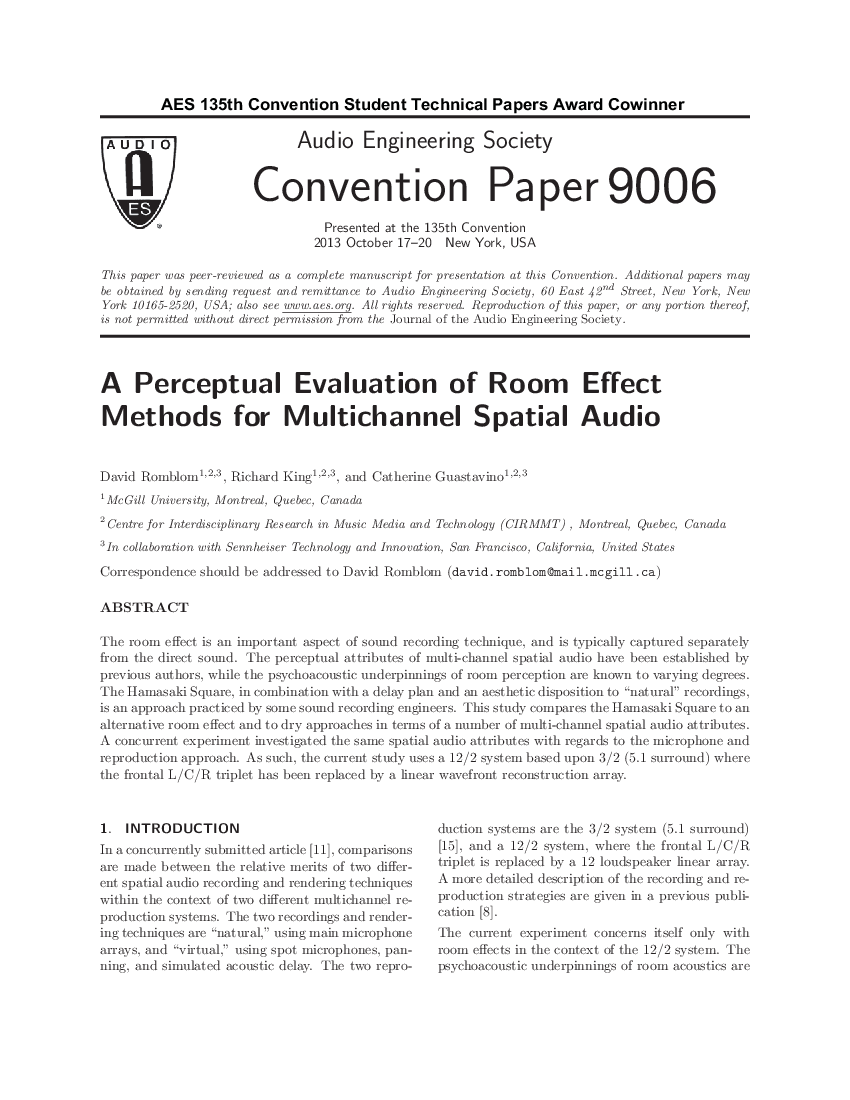Home / Publications / E-library page
You are currently logged in as an
Institutional Subscriber.
If you would like to logout,
please click on the button below.
Home / Publications / E-library page
Only AES members and Institutional Journal Subscribers can download
The room effect is an important aspect of sound recording technique and is typically captured separately from the direct sound. The perceptual attributes of multichannel spatial audio have been established by previous authors, while the psychoacoustic underpinnings of room perception are known to varying degrees. The Hamasaki Square, in combination with a delay plan and an aesthetic disposition to "natural" recordings, is an approach practiced by some sound recording engineers. This study compares the Hamasaki Square to an alternative room effect and to dry approaches in terms of a number of multichannel spatial audio attributes. A concurrent experiment investigated the same spatial audio attributes with regard to the microphone and reproduction approach. As such, the current study uses a 12/2 system based upon 3/2 (5.1 surround) where the frontal L/C/R triplet has been replaced by a linear wavefront reconstruction array. AES 135th Convention Student Technical Papers Award Cowinner
Author (s): Romblom, David; King, Richard; Guastavino, Catherine
Affiliation:
McGill University, Montreal, Quebec, Canada; Centre for Interdisciplinary Research in Music Media and Technology (CIRMMT), Montreal, Quebec, Canada; The Centre for Interdisciplinary Research in Music Media and Technology, Montreal, Quebec, Canada
(See document for exact affiliation information.)
AES Convention: 135
Paper Number:9006
Publication Date:
2013-10-06
Import into BibTeX
Session subject:
Spatial Audio
Permalink: https://aes2.org/publications/elibrary-page/?id=17054
(146KB)
Click to purchase paper as a non-member or login as an AES member. If your company or school subscribes to the E-Library then switch to the institutional version. If you are not an AES member Join the AES. If you need to check your member status, login to the Member Portal.

Romblom, David; King, Richard; Guastavino, Catherine; 2013; A Perceptual Evaluation of Room Effect Methods for Multichannel Spatial Audio [PDF]; McGill University, Montreal, Quebec, Canada; Centre for Interdisciplinary Research in Music Media and Technology (CIRMMT), Montreal, Quebec, Canada; The Centre for Interdisciplinary Research in Music Media and Technology, Montreal, Quebec, Canada; Paper 9006; Available from: https://aes2.org/publications/elibrary-page/?id=17054
Romblom, David; King, Richard; Guastavino, Catherine; A Perceptual Evaluation of Room Effect Methods for Multichannel Spatial Audio [PDF]; McGill University, Montreal, Quebec, Canada; Centre for Interdisciplinary Research in Music Media and Technology (CIRMMT), Montreal, Quebec, Canada; The Centre for Interdisciplinary Research in Music Media and Technology, Montreal, Quebec, Canada; Paper 9006; 2013 Available: https://aes2.org/publications/elibrary-page/?id=17054